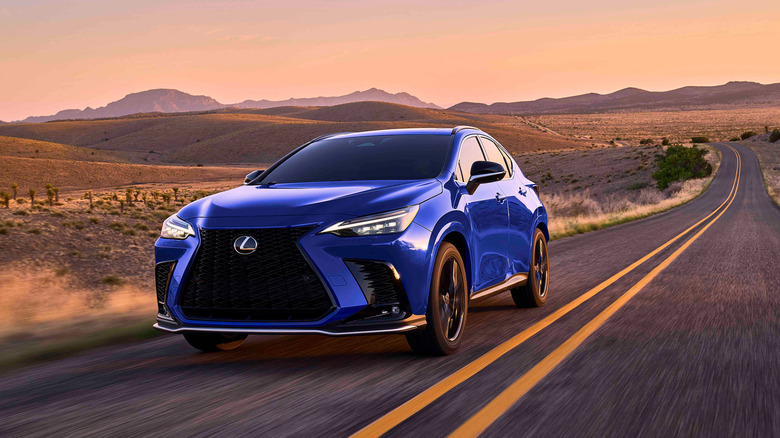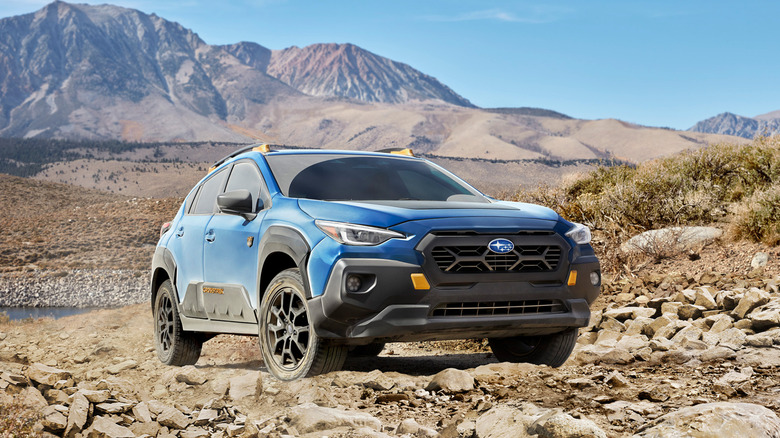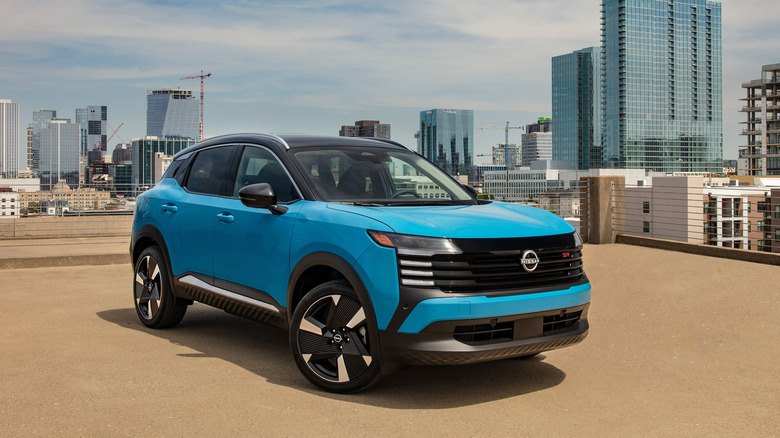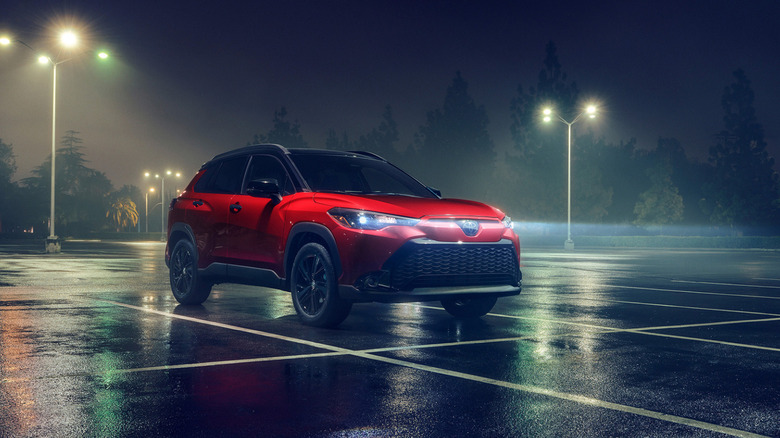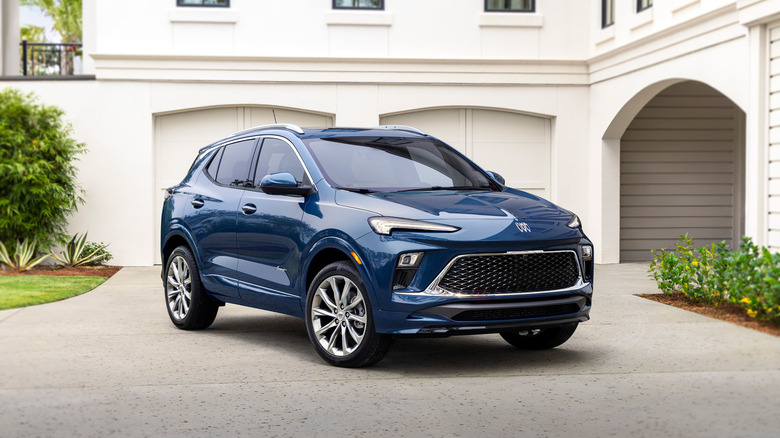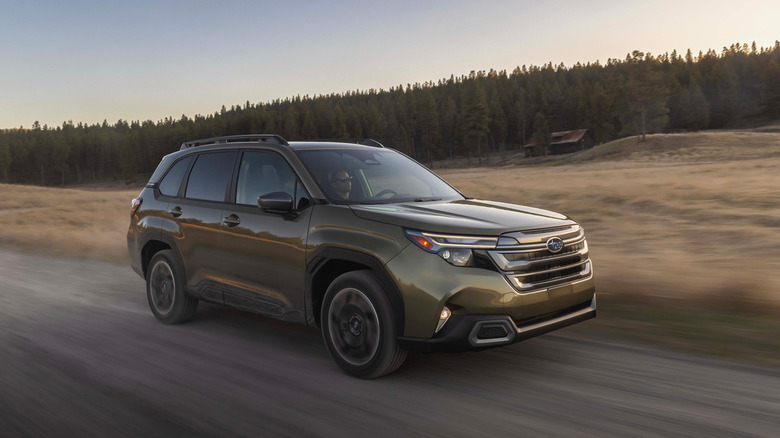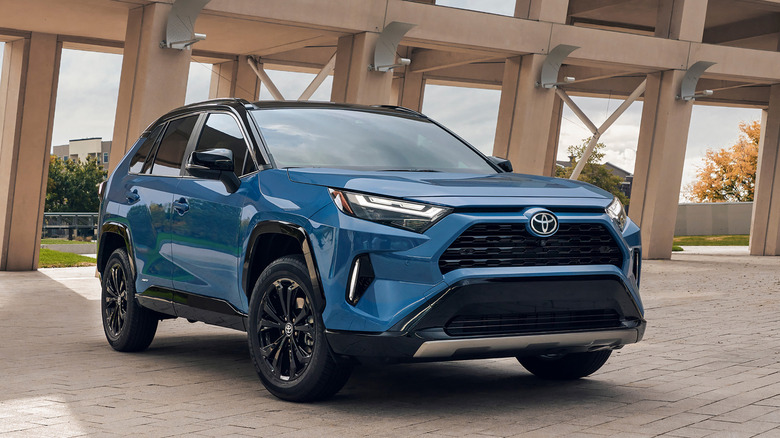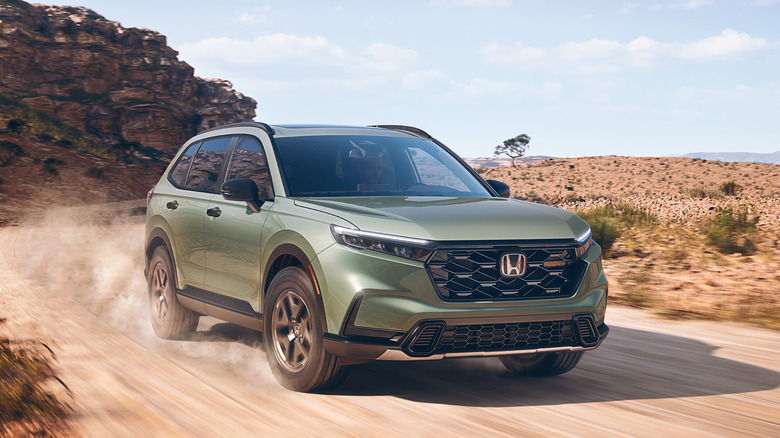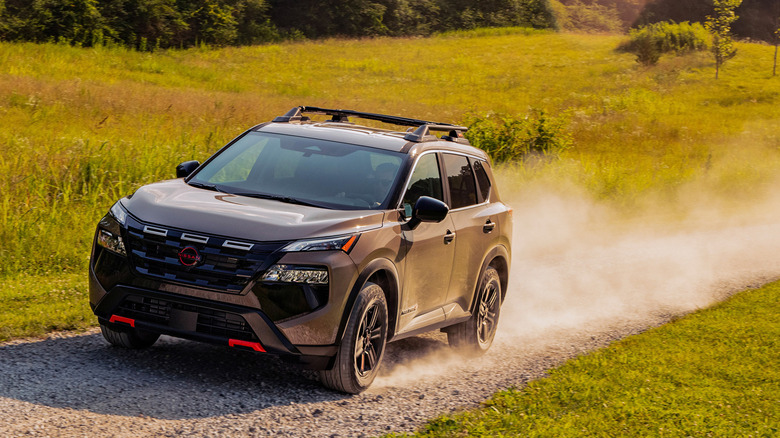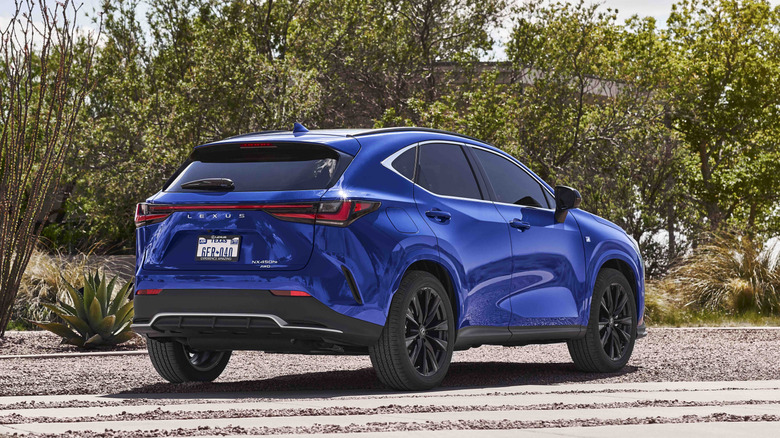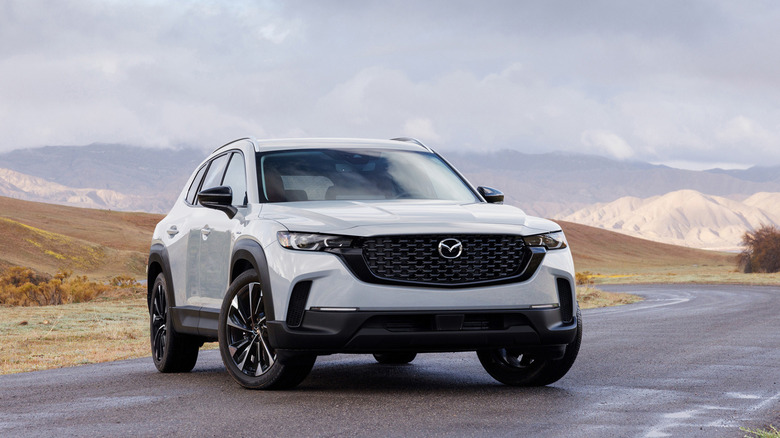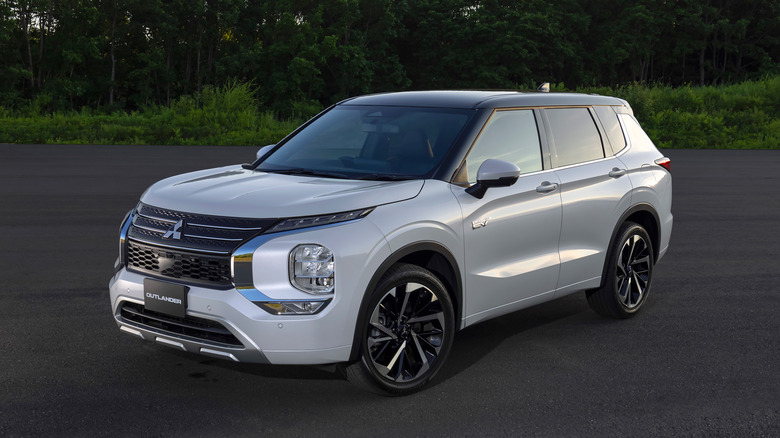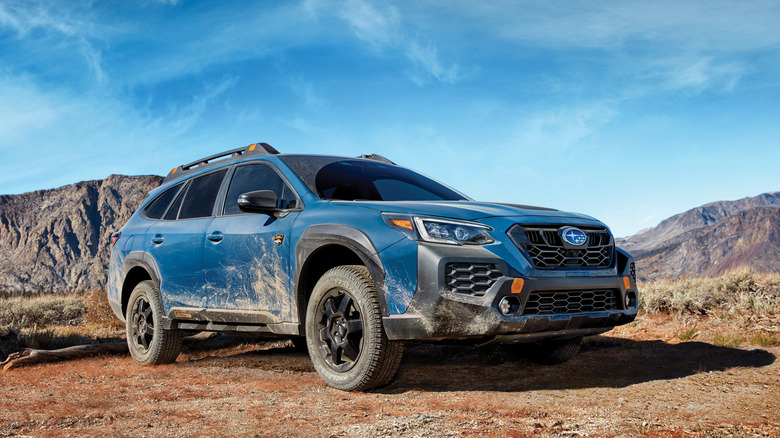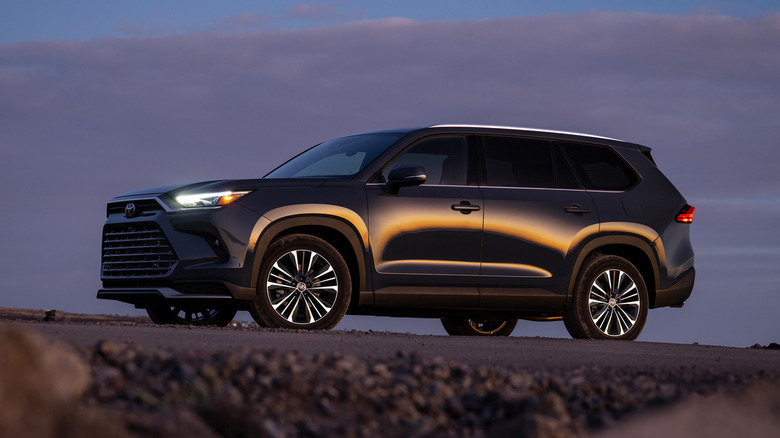13 New SUVs You Can Buy With A CVT Transmission
On paper, CVTs are the best transmission type. They are very compact and light, which has a positive effect on performance and efficiency. They also don't change through gears, and instead continuously alter the gear ratio, meaning no shift shock. CVTs keep engines in their optimum rpm range, further increasing efficiency and performance. According to the EPA, they can boost a car's fuel efficiency by 6%, which is significant. On top of that, CVTs are quite simple, with fewer moving parts than regular gearboxes, so they are easier to maintain.
Of course, CVTs have some disadvantages. Most people don't like the "rubber-band" acceleration with the engine constantly screaming in the background. CVTs can't transfer as much torque as torque-converter automatics, and are less durable, too. Even so, mainly due to their efficiency benefits, CVTs are quite common today, even in larger vehicles. Let's take a look at some of the new SUVs you can buy with a CVT and enjoy a smoother, more fuel-efficient ride.
2025 Subaru Crosstrek
They don't really offer a substantial difference over regular compact hatchbacks, but small crossovers are hugely popular lately. The Crosstrek, for instance, is a lifted Impreza. Still, people have a soft spot for lifted cars, so Crosstrek sales are booming, even as the Impreza itself seems headed for the axe soon.
The Crosstrek is a crossover we secretly don't hate. See, unlike small quasi-SUVs, this one is built to take you off the beaten path. Sure, it's no Wrangler, but it comes with standard all-wheel-drive and a solid 8.7-inch ground clearance. Heck, the off-road-focused Wilderness version sits 9.3 inches from the ground. It even has all-terrain tires! You don't get these features in any of its rivals.
However, while the Subaru Crosstrek Wilderness is dressed up nicely, it's also quite expensive. The base model starts at $27,980, while the Wilderness sits at $34,780. To be fair, you get a more potent 2.5-liter boxer producing 185 hp, compared to the 2.0-liter, 152-hp unit. Still, the Premium trim costs $29,230, and gets the larger engine.
Each trim comes with a CVT, too. Subaru's Lineartronic provides good power delivery and fuel efficiency in non-Wilderness models. The engine is still gutless, but that's typical for the category. Perhaps you should wait for the 194-hp 2026 Crosstrek Hybrid, which will arrive in dealerships this fall. And the Wilderness really suffers in refinement — the suspension is hard and quite audible, and the interior is downright cramped compared to the Forester.
2025 Nissan Kicks
Nissan added AWD to the Kicks for the 2025 model year, so the small SUV is way more competitive now. It got more power, too; instead of a measly 1.6-liter engine, it now has a 2.0-liter with 141 hp and 140 lb-ft of torque. Of course, like most vehicles with a Nissan badge, all Kicks models come with a CVT.
Yes, we know that the mention of a Nissan CVT induces narcolepsy, but in the Kicks, it's well sorted out. It's not fast, but that's expected for a car that starts at $23,220. Equipment levels are good, too; the mid-level Kicks SV, for instance, has a sizeable 12.3-inch infotainment, wireless Apple CarPlay and Android Auto, wireless charging pad, and hands-free unlock.
Earlier this year, colleague Alex Hevesy tested the high-end 2025 Nissan Kicks SR Premium AWD model and still found it to be affordable for the equipment on offer. The SR trim comes with 19-inch alloys and LED signature headlights, alongside Nissan's ProPILOT Assist safety suite. Meanwhile, the Premium package, for instance, adds luxury features like a panoramic moonroof, Bose sound system, remote engine start, heated mirrors, rain sensing wipers, and rear passenger under-seat heater ducts for just $1,500.
Yes, the Kicks might not be as rugged as the Crosstrek. It's also not the smoothest-riding crossover around, and not exactly fun to drive. Still, it's a cheap, well-equipped, small crossover SUV, so it's easy to turn a blind eye to its disadvantages.
2025 Toyota Corolla Cross
The Corolla Cross has enjoyed good success, with sales going up every year since it arrived in the U.S. But although both the gas and hybrid models come with a CVT, they are completely different transmissions.
The gas-powered Corolla Cross is paired to a Direct-Shift CVT, which employs a regular launch gear for better acceleration off the line and a classic "belt and pulley" CVT with a narrower belt angle for higher responsiveness. Meanwhile, the hybrid is equipped with Toyota's eCVT, which combines a planetary gearset with two electric motors to provide infinite ratios. In practice, both transmissions work similarly, so which one should you get?
Well, with a base price of $25,585, the 2.0-liter, 169-hp gas model is cheaper, but it's quite slow, and you only get 32-mpg combined (FWD) and 30-mpg combined (AWD). The hybrid starts at $29,945, and with 196 hp on tap, it's significantly quicker. It's also good for 42-mpg combined and has standard AWD.
Although affordable, the Toyota Corolla Cross Hybrid has a kryptonite in the latest Prius. The hybrid-only hatchback uses the same powertrain, but uses the combustion engine less frequently, so it's more refined. It looks much better, too, and has a much nicer interior. Heck, it even offers a similar cargo capacity. Another option is to wait for the improved 2026 Corolla Cross. The restyled model looks better and comes with a larger 10.5-inch touchscreen inside.
2026 Buick Encore GX
Want a small SUV with a bit more luxury? The Buick Encore GX is a tad more expensive than its closest rivals, starting at $27,295. However, it brings an upscale interior to the table, particularly in the Avenir trim. At $32,795, the Encore GX Avenir is expensive, but it brings power-adjustable, perforated leather front seats with an embroidered Avenir logo and heating. On the outside, the high-end model is equipped with 19-inch wheels with Pearl Nickel finish and an Avenir grille with bright chrome accents.
The Avenir also comes with the more powerful 1.3-liter turbocharged three-cylinder engine, good for 155 hp. Meanwhile, the base model gets a smaller 1.2-liter three-cylinder turbo that produces 137 hp. Both powertrains are paired with a CVT in front-wheel-drive models and a nine-speed automatic on AWD models. Thus, with adding only $1,600 to the price, the AWD option seems like the obvious choice.
But there is one area where the CVT is the clear winner — efficiency. CVTs are usually lighter on fuel, and the Encore GX showcases that perfectly. At 30-mpg combined, the CVT-equipped 1.3-liter gives you three more miles to the gallon. Yes, AWD is also detrimental to efficiency, but the difference is smaller on other vehicles; notably, the Corolla Cross gets 32 mpg (FWD) and 30 mpg (AWD).
2025 Subaru Forester
Subaru launched the Forester as a brand-new model for the 2025 model year. With classier aesthetics, more dynamic, yet smoother ride, and better tech inside, the 2025 Forester looks to trade punches with the Toyota RAV4 and Honda CR-V. The 2.5-liter boxer engine remained for the new generation, though with slightly different power and torque figures. The 2024 Forester had 182 hp and 176 lb-ft, while the 2025 model has 180 hp and 178 lb-ft of torque. Subaru's Lineartronic CVT also carries over, though now designed for a smoother and quieter operation.
The bottom line — the 2025 Forester is everything you expect from a Subbie crossover SUV. It's slowish and uninspiring to drive, although Subaru tried to spice up things with seven or eight faux gears. Moreover, the new 11.6-inch STARLINK infotainment already feels dated. Oh, and the gas engine is good for only 29-mpg combined.
Fortunately, the 2025 Forester is also available as a hybrid, built around a 2.5-liter Atkinson-cycle engine. With 194 hp, the hybrid is quicker and gets a better fuel economy of 35-mpg combined. Both versions are very practical and comfortable on the road. Thanks to the standard AWD, 8.7-inch ground clearance — 9.3 inches on the Wilderness model, the 2025 Forester is off-road-ready, too. It starts at $31,415, though for $34,805, the Premium trim is much better equipped.
2025 Toyota RAV4 Hybrid
The RAV4 has been the best-selling non-truck vehicle in the U.S. thus far in 2025, despite being launched way back in 2018. And things are looking bland for Toyota's rivals with the imminent arrival of the brand-new, hybrid-only 2026 RAV4. The next-gen model looks better on the outside, and it's more powerful, too. Inside, there is more tech than ever, but also physical buttons for the climate.
The 2026 RAV4 will reach showrooms later this year, with a higher base price due to the standard hybrid powertrain. Thus, if you want an affordable RAV4, react fast to snatch the 2025 gas model, which starts at $31,000. It's equipped with a 2.5-liter four-cylinder, good for 203 hp, and an eight-speed automatic.
The 2025 RAV4 Hybrid, just like all 2026 models, is of course equipped with an e-CVT and starts at $34,050. The hybrid produces 219 hp and has an EPA-rated range of 39-mpg combined, compared to 30 mpg for the regular model. Even so, for better or worse, the 2025 RAV4 Hybrid plays it safe in many areas. Notably, we liked the straightforward, easy to navigate cabin, but the tech does feel outdated. Also, while relatively spacious inside, the 2025 RAV4 doesn't feel as accommodating as its rivals.
2026 Honda CR-V
The 2026 Honda CR-V TrailSport is a niche too far, with rugged looks that don't bring significant off-road benefits. Other than that, though, it's a stellar compact crossover. The CR-V is roomy and practical inside, with a well-executed dashboard that's easy to live with. Honda was also smart to include physical knobs for the climate, though the infotainment touchscreen is relatively small at 9.0 inches. Still, the CR-V is pleasant to drive, providing smooth ride and good stability in the corners.
Both powertrain options are also good, though the hybrid is peppier and far more economical. The gas-only 1.5-liter turbocharged four-cylinder starts at $32,315 and produces 190 hp. It's paired exclusively with a CVT. In front-wheel-drive configuration, it's EPA-rated at 30-mpg combined (FWD), while the AWD model gets 29-mpg combined. The CR-V Hybrid is pricier at $37,025, but the electrified 2.0-liter four-cylinder produces 204 hp, while sipping fuel at 40-mpg combined for the FWD model, and 37 mpg for the AWD. The hybrid is also equipped with a CVT.
All CR-V models come as standard with Honda's Sensing safety suite, which includes things like collision mitigation braking system, road departure mitigation system, and driver-attention monitor.
2025 Nissan Rogue
Unlike its closest Japanese rivals, the Nissan Rogue isn't available with a hybrid powertrain. Even so, it gets an excellent fuel economy of 33-mpg combined in FWD configuration, and 31-mpg combined in AWD. It's all thanks to the three-cylinder, 1.5-liter turbocharged engine and CVT combo. Not convinced by the lower cylinder count? The engine also makes 201 hp, more than the CR-V and Forester.
But it's not just the engine that's good — the 2025 Nissan Rogue is perfectly fine in other areas as well. It's very practical, with enough room for adults in both rows, numerous storage cubbies, and good cargo space. Like Honda and Toyota, Nissan also kept the physical buttons for the climate and added shortcut physical buttons for the frequently used functions inside the infotainment system. Still, you can have an optional 12.3-inch screen with Google software, which is on par with most of its rivals.
As for the price, the base Rogue starts at a very competitive $29,980. Still, the high-end Premium trim we tested, plus some add-ons, pushes the price beyond $40,000. For those kinds of money, you can have the RAV4 Hybrid and CR-V Hybrid, both of which offer better fuel economy and performance.
2025 Lexus NX 350h & 450h
Buyers often choose hybrids for their excellent fuel economy, but the latest Lexus NX 350h proves there's more to life than mpg. Make no mistake — it's still very fuel-efficient, with a 39-mpg combined EPA rating, despite packing potent 239 hp and standard AWD.
However, you are getting a much nicer cabin than non-premium compact SUVs. The NX 350h is packed with gadgets inside, like a massive 14.0-inch touchscreen, alongside premium materials and excellent fit and finish. As you'd expect from a Lexus, the ride is supple and quiet, while the smooth e-CVT elevates plushness even further. The NX 350h is not the most spacious compact SUV around, though it's not too bad, either.
The PHEV NX 450h+ model is also equipped with e-CVT transmission. However, it's significantly more powerful, producing 302 hp. Its 18.1-kWh battery also provides a 37-mile EV-only range. However, the price delta is also quite significant; the NX 350h starts at $46,600, while the NX 450h+ costs a whopping $62,415. Yes, the PHEV's standard trim is Luxury, but even then, the regular hybrid costs $52,665 with the same trim. Lexus also offers the cheaper, gas-only NX 250 and NX 350, equipped with an eight-speed automatic.
2025 Mazda CX-50 Hybrid
The Mazda CX-50 has been around since 2022, designed as a more rugged alternative to the CX-5. Thus, it also came with the same engines — a 2.5-liter naturally aspirated unit with 187 hp, and a 2.5-liter turbo with 256 hp, both paired with a six-speed auto. However, to truly compete in the category, Mazda needed a more fuel-efficient model, so for the 2025 model year, it launched the CX-50 Hybrid.
The electrified model uses Toyota's proven powertrain from the RAV4 Hybrid, which combines a 2.5-liter four-cylinder with three electric motors for an output of 219 hp. The hybrid comes standard with AWD and an e-CVT transmission. Although this has changed how the crossover drives, the Mazda CX-50 Hybrid was still worth the wait for the fuel economy benefits alone. With a combined EPA rating of 38 mpg, the hybrid trumps the 187-hp gas engine's 28 mpg. The CX-50 Hybrid starts at $35,915 in the Preferred trim, while the base gas model $33,345 in the same trim, so choosing the electrified model is really a no-brainer.
Yes, the Toyota-sourced hybrid powertrain can feel short on power at times, but the CX-50 still drives superbly well through the corners. The cabin is also comfortable and well-executed, with high-quality materials, though the infotainment system feels a bit dated compared to its rivals.
2025 Mitsubishi Outlander
The latest Mitsubishi Outlander shares the platform with the Nissan Rogue, though with a three-row seating configuration. Unlike the latest iteration of its cousin, though, the Outlander still hasn't received the 1.5-liter three-cylinder turbo with 201 hp. Instead, it uses the outdated 2.5-liter four-cylinder with 181 hp, mated to a CVT.
At $32,005, the base model is very competitive, but options can inflate the price dramatically. For that amount, you are getting a practical three-row SUV, with a quiet and roomy cabin, except for the cramped third row. Still, the engine can feel gutless, especially if you plan to use all three rows. The CVT doesn't help matters, making the engine feel even less responsive.
Thus, we recommend buying the Mitsubishi Outlander PHEV instead. The plug-in hybrid combines a Mitsubishi-designed 2.4-liter four-cylinder with two electric motors and an additional motor on the rear axle (AWD). It produces 248 hp, so it's quite a bit faster. Like the gas model, the Outlander PHEV also has a CVT transmission, though this one doesn't use a belt drive, and instead utilizes the two electric motors to change the gear ratio. Thanks to the sizeable 16.8-kWh battery, the Outlander PHEV can run 38 miles on electricity alone.
2025 Subaru Outback
The 2025 Subaru Outback offers luxury features without the premium price, and remains an excellent option for buyers that want station-wagon-like practicality and all-weather usability. With standard AWD and an 8.7-inch ground clearance, the Outback is also one of the most capable crossovers on the trail. The Wilderness model even has a higher 9.5-inch ground clearance, special off-road suspension, alongside underside protection, so it's even better for off the beaten path.
That said, you really need to go for the optional turbo engine to have fun. The base 2.5-liter boxer starts at $31,415, though it produces just 182 hp and has a hard time moving the heavy Outback. It's rated at 28-mpg combined. The 2.4-liter turbo produces much higher 260 hp and feels more energetic, though it's less economical at 25 mph. Both are paired with a CVT, though with special tuning to make it feel like a regular automatic.
With all that said, the brand-new 2026 Outback, due to reach dealerships soon, seems like a more enticing option. Its design is questionable at best, but it comes with better safety tech, including hands-free driving, and a significantly improved infotainment system. Thanks to the 2.0-inch higher roof, the 2026 Outback has more headroom inside, and the cargo volume is up by 2 cubic inches.
2025 Toyota Grand Highlander Hybrid
In 2023, Toyota launched the Grand Highlander as a bigger, more versatile version of its three-row Highlander SUV. When we tested the 2024 Toyota Grand Highlander Hybrid Max, we found that it's a truly practical SUV, with enough room for adults in all three rows and large cargo capacity. The $56,185 Hybrid Max trim is also incredibly potent, packing 362 hp from an electrified 2.4-liter four-cylinder turbo and a six-speed auto.
Even so, the regular, e-CVT-equipped hybrid might be a better option for most people. It's significantly cheaper, starting at $45,705, while still producing respectable 245 hp. Fuel efficiency is also better, with the FWD model being rated at 36-mpg combined, while the AWD at 34 mpg. Meanwhile, the Hybrid Max only gets 27-mpg combined. Another important difference — the regular hybrid can seat up to eight people, while the Hybrid Max is strictly a seven-seater with captain chairs in the second row. Toyota also offers a regular 2.4-liter turbocharged four-cylinder with 265 hp and an eight-speed automatic, which is slightly cheaper than the hybrid at $42,355 for the FWD model.
